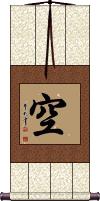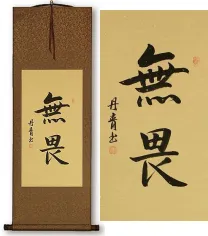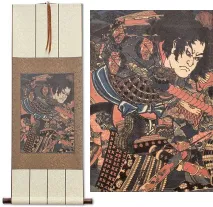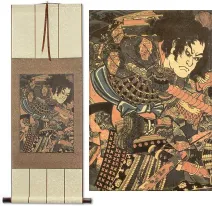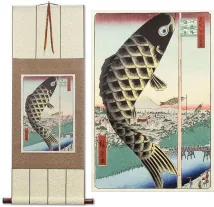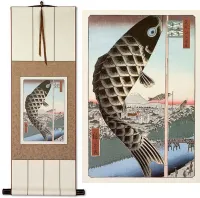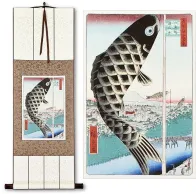Many custom options...
And formats...

No Ego in Chinese / Japanese...
Buy a No Ego calligraphy wall scroll here!
Personalize your custom “No Ego” project by clicking the button next to your favorite “No Ego” title below...
No Mind / Mushin
In Japanese, 無心 means innocent or without knowledge of good and evil. It literally means “without mind.”
無心 is one of the five spirits of the warrior (budo) and is often used as a Japanese martial arts tenet. Under that context, places such as the Budo Dojo define it this way: “No mind, a mind without ego. A mind like a mirror which reflects and dos not judge.” The original term was “mushin no shin,” meaning “mind of no mind.” It is a state of mind without fear, anger, or anxiety. Mushin is often described by the phrase “Mizu no Kokoro,” which means “mind like water.” The phrase is a metaphor describing the pond that clearly reflects its surroundings when calm but whose images are obscured once a pebble is dropped into its waters.
This has a good meaning in conjunction with Chan / Zen Buddhism in Japan. However, out of that context, it means mindlessness or absent-mindedness. To non-Buddhists in China, this is associated with doing something without thinking.
In Korean, this usually means indifference.
Use caution and know your audience before ordering this selection.
More info: Wikipedia: Mushin
Sky / Ether / Void / Emptiness / Unreality
(Used in Japanese version of five elements)
空 is a single character that means empty, void, hollow, vacant, vacuum, blank, nonexistent, vacuity, voidness, emptiness, non-existence, immateriality, unreality, the false or illusory nature of all existence, and being unreal.
In the Buddhist context, this relates to the doctrine that all phenomena and the ego have no reality but are composed of a certain number of skandhas or elements, which disintegrate. The void, the sky, space. The universal, the absolute, complete abstraction without relativity. The doctrine further explains that all things are compounds, or unstable organisms, possessing no self-essence, i.e. are dependent, or caused, come into existence only to perish. The underlying reality, the principle of eternal relativity, or non-infinity, i.e. śūnya, permeates all phenomena making possible their evolution.
From Sanskrit and/or Pali, this is the translation to Chinese and Japanese of the title śūnya or śūnyatā.
In Japanese, when pronounced as “ron” (sounds like “roan”) this can be a given name. It should be noted that this Kanji has about 5 different possible pronunciations in Japanese: kuu, kara, sora, ron, and uro. 空 is also an element in the Japanese version of the five elements.
This in-stock artwork might be what you are looking for, and ships right away...
Gallery Price: $108.00
Your Price: $59.88
Gallery Price: $108.00
Your Price: $59.88
Gallery Price: $61.00
Your Price: $33.88
Gallery Price: $61.00
Your Price: $33.88
Gallery Price: $61.00
Your Price: $33.88
Gallery Price: $108.00
Your Price: $59.88
Gallery Price: $90.00
Your Price: $49.88
Gallery Price: $90.00
Your Price: $49.88
Not the results for no ego that you were looking for?
Below are some entries from our dictionary that may match your no ego search...
| Characters If shown, 2nd row is Simp. Chinese |
Pronunciation Romanization |
Simple Dictionary Definition |
空 see styles |
kòng kong4 k`ung kung ron ろん |
More info & calligraphy: Sky / Ether / Void / Emptiness / Unreality(1) empty air; sky; (2) {Buddh} shunyata (the lack of an immutable intrinsic nature within any phenomenon); emptiness; (3) (abbreviation) (See 空軍) air force; (noun or adjectival noun) (4) fruitlessness; meaninglessness; (noun or adjectival noun) (5) (See 五大・1) void (one of the five elements); (can be adjective with の) (6) {math} empty (e.g. set); (female given name) Ron śūnya, empty, void, hollow, vacant, nonexistent. śūnyatā, 舜若多, vacuity, voidness, emptiness, non-existence, immateriality, perhaps spirituality, unreality, the false or illusory nature of all existence, the seeming 假 being unreal. The doctrine that all phenomena and the ego have no reality, but are composed of a certain number of skandhas or elements, which disintegrate. The void, the sky, space. The universal, the absolute, complete abstraction without relativity. There are classifications into 2, 3, 4, 6, 7, 11, 13, 16, and 18 categories. The doctrine is that all things are compounds, or unstable organisms, possessing no self-essence, i.e. are dependent, or caused, come into existence only to perish. The underlying reality, the principle of eternal relativity, or non-infinity, i.e. śūnya, permeates all phenomena making possible their evolution. From this doctrine the Yogācārya school developed the idea of the permanent reality, which is Essence of Mind, the unknowable noumenon behind all phenomena, the entity void of ideas and phenomena, neither matter nor mind, but the root of both. |
無我 无我 see styles |
wú wǒ wu2 wo3 wu wo muga むが |
More info & calligraphy: Selflessness(1) selflessness; self-effacement; self-renunciation; (2) {Buddh} anatta; anatman; doctrine that states that humans do not possess souls; (female given name) Muga anātman; nairātmya; no ego, no soul (of an independent and self-contained character), impersonal, no individual independent existence (of conscious or unconscious beings, anātmaka). The empirical ego is merely an aggregation of various elements, and with their disintegration it ceases to exist; therefore it has nm ultimate reality of its own, but the Nirvāṇa Sūtra asserts the reality of the ego in the transcendental realm. The non-Buddhist definition of ego is that it has permanent individuality 常一之體 and is independent or sovereign 有主宰之用. When applied to men it is 人我, when to things it is 法我. Cf. 常 11. |
我 see styles |
wǒ wo3 wo ga が |
I; me; my (1) {Buddh} obstinacy; (2) atman; the self; the ego I, my, mine; the ego, the master of the body, compared to the ruler of a country. Composed of the five skandhas and hence not a permanent entity. It is used for ātman, the self, personality. Buddhism takes as a fundamental dogma 無我, i.e. no 常我, no permanent ego, only recognizing a temporal or functional ego. The erroneous idea of a permanent self continued in reincarnation is the source of all illusion. But the Nirvana Sutra definitely asserts a permanent ego in the transcendental world, above the range of reincarnation; and the trend of Mahāyāna supports such permanence; v. 常我樂淨. |
三修 see styles |
sān xiū san1 xiu1 san hsiu san shū |
The three ways of discipline, i.e. three śrāvaka and three bodhisattva ways. The three śrāvaka ways are 無常修 no realization of the eternal, seeing everything as transient; 非樂修 joyless, through only contemplating misery and not realizing the ultimate nirvāṇa-joy; 無我修 non-ego discipline, seeing only the perishing self and not realizing the immortal self. The bodhisattva three are the opposite of these. |
九道 see styles |
jiǔ dào jiu3 dao4 chiu tao kudō |
idem 九有情居.; The nine truths, or postulates: impermanence; suffering; voidness (or unreality of things); no permanent ego, or soul; love of existence or possessions, resulting in suffering; the opposite (or fear of being without them), also resulting in suffering; the cutting off of suffering and its cause; nirvāṇa with remainder still to be worked out; complete nirvāṇa. |
倶空 see styles |
jù kōng ju4 kong1 chü k`ung chü kung kukū |
Both or all empty, or unreal, i.e. both ego and things have no reality. |
相空 see styles |
xiàng kōng xiang4 kong1 hsiang k`ung hsiang kung sōkū |
The unreality of form; the doctrine that phenomena have no reality in themselves, in contrast with that of Hīnayāna which only held that the ego had no reality. |
二無我 二无我 see styles |
èr wú wǒ er4 wu2 wo3 erh wu wo ni muga |
The two categories of anātman: — 人無我 no (permanent) human ego, or soul; 法無我 no (permanent) individuality in or independence of self or of things. |
偏小情 see styles |
piān xiǎo qíng pian1 xiao3 qing2 p`ien hsiao ch`ing pien hsiao ching henshō no jō |
The partial or narrower Hīnayāna idea that though the ego is unreal, things are real. |
四念處 四念处 see styles |
sì niàn chù si4 nian4 chu4 ssu nien ch`u ssu nien chu shinenjo |
Four objects on which memory or the thought should dwell— the impurity of the body, that all sensations lead to suffering, that mind is impermanent, and that there is no such thing as an ego. There are other categories for thought or meditation.; (四念處觀); 四念住 smṛtyupasthāna. The fourfold stage of mindfulness, thought, or meditation that follows the 五停心觀 five-fold procedure for quieting the mind. This fourfold method, or objectivity of thought, is for stimulating the mind in ethical wisdom. It consists of contemplating (1) 身 the body as impure and utterly filthy; (2) 受 sensation, or consciousness, as always resulting in suffering; (3) 心 mind as impermanent, merely one sensation after another; (4) 法 things in general as being dependent and without a nature of their own. The four negate the ideas of permanence, joy, personality, and purity 常, 樂, 我, and 淨, i. e. the four 顚倒, but v. 四德. They are further subdivided into 別 and 總 particular and general, termed 別相念處 and 總相念處, and there are further subdivisions. |
空無我 空无我 see styles |
kōng wú wǒ kong1 wu2 wo3 k`ung wu wo kung wu wo kū muga |
Unreal and without ego. 空無邊處. v. 空處. |
俺が俺が see styles |
oregaorega おれがおれが |
(expression) (1) (masculine speech) me, me, me; (exp,adj-no) (2) egotistic; ego-driven |
四優檀那 四优檀那 see styles |
sì yōu tán nà si4 you1 tan2 na4 ssu yu t`an na ssu yu tan na shi udanna |
yu-t'an-na, ? udāna, the four dogmas: all is impermanent, all is suffering, there is no ego, nirvana. |
我空眞如 see styles |
wǒ kōng zhēn rú wo3 kong1 zhen1 ru2 wo k`ung chen ju wo kung chen ju gakū shinnyo |
The Hīnayāna doctrine of impersonality in the absolute, that in truth there is no ego; this position abrogates moral responsibility, cf. 原人論. |
空解脫門 空解脱门 see styles |
kōng jiě tuō mén kong1 jie3 tuo1 men2 k`ung chieh t`o men kung chieh to men kū gedatsu mon |
The gate of salvation or deliverance by the realization of the immaterial, i.e. that the ego and things are formed of elements and have no reality in themselves; one of the three deliverances. |
The following table may be helpful for those studying Chinese or Japanese...
| Title | Characters | Romaji (Romanized Japanese) | Various forms of Romanized Chinese | |
| No Mind Mushin | 無心 无心 | mu shin / mushin | wú xīn / wu2 xin1 / wu xin / wuxin | wu hsin / wuhsin |
| Sky Ether Void Emptiness Unreality | 空 | kuu / kara / sora / ron ku / kara / sora / ron | kōng / kong1 / kong | k`ung / kung |
| In some entries above you will see that characters have different versions above and below a line. In these cases, the characters above the line are Traditional Chinese, while the ones below are Simplified Chinese. | ||||
Successful Chinese Character and Japanese Kanji calligraphy searches within the last few hours...

